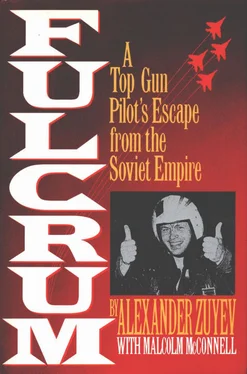Now that I had acquired Shatravka visually, I switched to his radio channel as a safety precaution. I also intended to probe him psychologically. Even as my simulated missiles were electronically converging on Shatravka to “destroy” his aircraft, I unveiled my next deceptive gambit.
“Rubege odin,” I called, a message I knew both Shatravka and the opponent battle controller would also receive. “Radar lock-on.”
I wanted them to think I was still at maximum lock-on range even though I had already launched.
Then, as my simulated missiles closed on Shatravka, I called, “Range Two” and “Range Three,” as if I had just launched my missiles.
“Enemy on the right,” I heard his controller warn.
He banked into a diving roll toward me in a vain effort to break my lock-on. But it was too late. He was already dead. As I had hoped, Shatravka was blinded by the afternoon sun and unable to achieve “tallyho,” visual contact.
Now I planned to kill him again, first with my infrared missiles and then with the gun.
I switched the sensor control knob from “radar” to “close combat infrared” and my HUD lit up with IRST target imagery. Shatravka was still banking into me, and I hoped that we were closing too fast for him to use his helmet-mounted sight. But my standard IRST sensor in the dome on my nose was tracking him. The two narrow vertical range lines of the IRST lock-on zone hung in the center of the HUD. My finger was poised on the missile trigger as I banked hard right into his approach. As soon as the gray blur of his aircraft entered the “ladder” of the lock-on zone, my headset buzzed with launch approval and I squeezed the trigger. A simulated Archer was on its way.
“Pusk,” I called, announcing a lock-on launch of an Archer. Shatravka was “dead” again. Actually, had I fired a real missile, he might have survived, but his plane would have been destroyed. The R-73, which NATO called the Archer, was almost impossible to evade in these close, highly dynamic encounters. The heat seeking sensor head was linked to its own logic memory system that resisted IR decoy flares. And because the missile employed a thrust vector system, it could turn inside any known fighter, no matter how skilled the pilot. An Archer literally followed its nose straight up the tail pipe of the enemy to explode inside his engine. But the missile’s warhead was relatively small. We called it our “humane” weapon; it killed the enemy’s engine, but not the pilot, who would hopefully be able to eject even after a solid hit.
Shatravka was still closing, and I rolled harder with him to keep his aircraft locked on. The beauty of the new Archer was you could engage these rapidly converging targets head-on. I still had a good tone, and another simulated missile automatically launched.
“Pusk,” I called again.
Shatravka slashed past me in a transonic blur. I retarded my throttles to idle and pulled back hard on the stick. Once more I was pressed into my seat, and I saw the G-indicator on my HUD increase from 6 to 7.5. I was using this high-G energy to reduce speed and minimize my turning radius. Shatravka was out there somewhere below to my right, in his own high-G “arcing turn", trying to maneuver for missile lock-on.
I kept the stick full back against my left thigh, and the aircraft pitched up toward a low-energy turn with the nose reaching the maximum maneuverable angle of attack, twenty-four degrees. The stall limiter immediately engaged, knocking the stick forward in my hand and reducing my AOA. I had achieved my goal of bleeding off energy and reversing course well inside Shatravka’s wider turn radius.
Just before a full stall, I jammed the throttles to afterburner and kept the stick in my lap. The Fulcrum accelerated, thrusting me against my ejection seat. I managed the best turn this Fulcrum had to offer and arrived at his six o’clock.
He had made the common mistake of relatively inexperienced MiG-29 pilots. By keeping his power settings too high, Shatravka flew wide-radius arcing turns, allowing me to get inside of him. I had been flying this powerful Fulcrum as long as any regimental line pilot in the Soviet Air Force. I had learned how to manage my energy and not to arc. It was not how fast you flew through the sky but where you placed your aircraft relative to your opponent in order to achieve a quick kill.
Shatravka now banked into a tight diving barrel roll and I rolled with him. It was time to kill him with the gun. The horizon spun crazily past my canopy, and I was aware of the altitude digits winding down on the upper right corner of my HUD while my airspeed increased dramatically on the opposite corner. But, like a hound, I had a taste of blood in my mouth. Reaching instinctively with my left hand, I flipped my weapons sensor zone switch to “narrow field of view” so that the IRST scanner would lock on quicker. The gunsight aiming circle wavered across Shatravka’s aircraft, and I eased my nose up and right to move the fixed cross hairs on the HUD to overlap the circle and the opponent fighter. I had set the fire-rate switch to “burst,” which meant twenty-five 30mm rounds would fire for each second my finger was on the trigger. The GSh-301 was a very accurate cannon. When the enemy was within that aiming circle, locked in the cross hairs, he was dead. This cannon simply did not miss.
I saw a bold ‘A’ appear on the left margin of the HUD and knew my laser range finder was probing him with an invisible finger, feeding the firing solution into my weapons computer. At this close range I hoped that Shatravka did not look back over his shoulder and catch the laser full in the face. He was an arrogant bastard and a Communist true believer, but I certainly didn’t want to blind him with my laser.
Still he rolled, and still I kept behind him. Almost, but not quite. Shatravka’s gray fuselage slid into the aiming circle. The cross hairs straddled his cockpit and wings. I heard the steady tone of laser/IRST lock-on. Now.
I squeezed the gun trigger on the stick. “Ogon,” I called. “Firing.”
Just as I killed my opponent for the third time, I heard Nikolai call, “Pusk.” He had killed Major Chayka with a missile.
Too late, Shatravka finally did something intelligent. He chopped power and dropped off in a leaf spiral toward the sea, hoping I would dive past him into his own IRST kill zone. If I hadn’t been anticipating his maneuver, I would have lost him. But I had already cut my own throttles and used the air brakes to stay behind him.
“Ogon,” I called for good measure.
My flight was victorious. I heard Shatravka’s gruff, sullen voice announce he was separating. The dogfight was over, and he and his wingman headed north to complete their own individual training maneuvers. Nikolai was scheduled for cannon runs on the Kulevi coastal poligon rectangular weapons range. He checked in with GCI and received an altitude and vector back to the coast.
I was alone over the Black Sea, still only minutes away from Turkey. But I shook my head, rejecting that final temptation. I knew the Ruslan GCI was watching me on radar, so I leveled off and proceeded with the remainder of my scheduled sortie maneuvers.
I completed one fast, tight climbing combat turn and rolled into a hard right bank on the second. As the G-indicator on my HUD blinked to 8, I dragged the throttles back and centered the stick, letting the airplane mush into level flight without completing the turn.
I breathed deeply and licked my dry lips. It was time to begin the deception.
“Brigadier…350.” I made my voice hoarse and hesitant, then groaned and spoke through clenched teeth, as if in severe pain. “Finished… finished mission. I have a sharp pain in the back.”
I groaned again and let my breath hiss audibly in my mask.
Читать дальше










